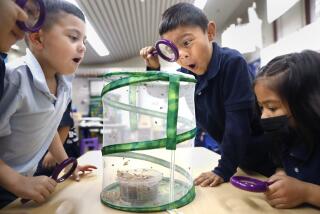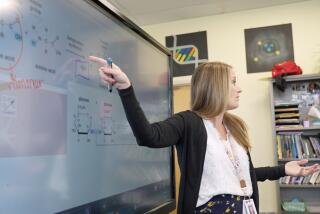Parents Get Tricks of the Teaching Trade
- Share via
Parents grunted like animals. Children shouted out words and squealed with glee. A paper wolf puppet roared. The Sonora Elementary School auditorium was downright boisterous on a recent Wednesday night. Reading was happening.
Literacy Night, the first event of its kind at this Costa Mesa school, was a family affair. Parents and their children, kindergartners through third-graders, traveled in small groups through three learning stations: storytelling, shared reading and interactive writing.
While the kids participated in interactive lessons with teachers and literacy volunteers, the parents were encouraged to take note of the teaching techniques so they could use them at home. Learning stations were set up in English and Spanish.
“It takes everyone to make all of our children successful readers,” Sonora Principal Lorie Hoggard said. “We want to empower parents with some of the tools we demonstrated tonight.”
Hoggard said teachers know when students read with their parents. “It’s not that we’ve done a scientific study, but you can tell the parents that are involved in their children’s education, reading with them and helping them with their homework,” she said. “The kids are more confident in the classroom. They’re more prepared, they make more progress.”
To that end, Literacy Night was aimed at making parents into comfortable teachers.
At the storytelling station, volunteer Pat Tompkins used a felt storyboard to embellish her tale about Bucky the goat. Parents received handouts that explained why storytelling--which is done without books--is important: It helps children to develop language and vocabulary skills, and reinforces the ability to follow events in sequence.
At the Spanish language storytelling station, volunteer Ed Urbina used a very elaborate construction paper wolf puppet to help tell the story of “The Three Little Pigs.” The children giggled and squealed as the shaggy wolf huffed and puffed and roared.
In shared reading, parents learned, children are asked to read along with an adult. It allows new readers to take over the task gradually. At the shared reading station, third-grade teacher Susie Farnsworth challenged the children to think about the book “The Napping House” before she began to read it. “What do you think this book is going to be about?” she asked, showing off its cover and announcing its title.
Farnsworth asked 7-year-old Hannah Speer to help her turn the pages as she read. The children were encouraged to make sounds that go with the story: They clapped, clapped, clapped for thunder and howled “yelp, yelp, yelp” for wolves. Even though many of the children wouldn’t be able to read this book on their own, they are drawn in to the reading process. Parents can make their children part of the process, rather than simply reading while the child remains passive.
Next Hannah traveled with her parents, Debbie and Randy, and her older sister, Molly, 9, to the interactive writing station. In interactive writing, a child dictates sentences about an experience while the adult slowly writes. The children watch as the letters appear on paper. When children are ready, they can write in some of the words on their own or they can copy down what the adult has written.
First-grade teacher Maggie Kenney asked the children questions as she read them “The Little Yellow Chicken,” and assigned parts to her audience so that kids and parents could be a part of the reading exercise. Girls read the part of the bee. Boys read the part of the frog. And the parents, taking on the part of the beetle, could be heard yelling, “Stop bugging me.”
Kenney then led the children in a writing exercise about the book. On a large easel she wrote, “Once upon a time there was a . . . “--and a little boy stood on a chair to write “little” on the easel. Next it was Hannah’s turn. Since they were writing about the chicken in the book, Hannah wrote the word “yellow” in yellow ink. When she spelled it “yellwo” at first, Kenney told her she was very close to correct and then helped her reconfigure the word.
When each family had been to the three literacy stations, Principal Hoggard introduced former Anaheim Angels player Jay Johnstone, the author of three books, who took the stage to read Laura Numeroff’s “If You Give a Mouse a Cookie” in his deep, booming voice.
“Reading is a very, very wonderful thing that can help you learn about what’s going on in your city, your country and your world,” Johnstone told the children. “Reading is a great tool that can help make you smarter.”
(BEGIN TEXT OF INFOBOX / INFOGRAPHIC)
Reading With Your Child
If the reading goes well...
PRAISE when your child reads correctly
PRAISE when your child corrects a mistake by himself/herself
PRAISE when your child gets a word correct after you have prompted him or her
CONFIDENCE-BUILDING COMMENTS
* I liked the way you tried to help yourself.
* I saw how you got your mouth ready to say the first sound.
* You did a nice job working out the hard parts.
* Good for you! I noticed you tried ---------- when you had trouble. That’s what good readers do.
What to do when your child gets stuck...
WAIT!!! Give your child a chance to figure it out
If the mistake DOESN’T make sense: Prompt with clues about the MEANING of the story:
“You said ------------. Does that make sense?”
“What word would make sense here?”
If the mistake DOES make sense: Prompt with clues about LETTERS and SOUNDS of the word:
“What letter would you expect to see at the beginning (or end) of the word ----------?”
If your child says nothing: Ask him or her to go back to the beginning of the sentence and START AGAIN.
“Try that again.”
If the word is not correct after two prompts or after two attempts at pronouncing the word, then say the word for the child so he or she can go on.
“The word is ----------.”
(Jot down the word and come back after finishing the story to analyze it together.)
Source: Sonora Elementary School
More to Read
Sign up for Essential California
The most important California stories and recommendations in your inbox every morning.
You may occasionally receive promotional content from the Los Angeles Times.










